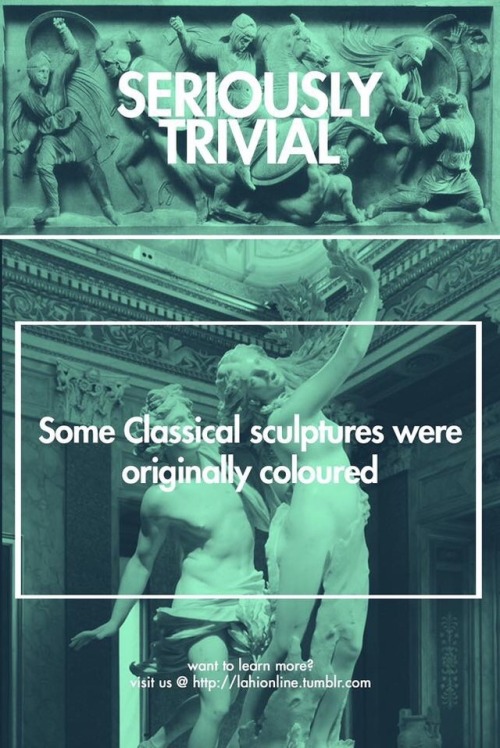#historical trivia
LAHi Presents: Seriously Trivial
They began with the reconstruction of noses, which at the time were cut off as punishment for adultery. The Sushruta Samhita records that a nose reconstruction method was invented wherein a patch of the cheek was used to fashion a new nose.
Sources:
Nicolò Manuzzi (1639-1717) and the first report of the Indian Rhinoplasty.
Sykes PJ, Santoni-Rugiu P, Mazzola RF. J Plast Reconstr Aesthet Surg. 2010 Feb; 63(2):247-50. Epub 2008 Dec 19.
The path of nasal reconstruction: from ancient India to the present.
Yalamanchili H, Sclafani AP, Schaefer SD, Presti P. Facial Plast Surg. 2008 Jan; 24(1):3-10.
Poster by: Nic Calilung
Post link
LAHi presents: Seriously Trivial
During the Japanese invasion of Joseon Korea in late 1500’s, the Japanese soldiers killed Korean civilians, including women and children, and took their noses as war trophies. It was a custom in East Asia to take the heads of slain enemies as a war trophy. But because heads were inconvenient to transport back to Japan during wartime, the Japanese took noses and ears of the slain people back to their country. Today, there are various monuments and tombs of those noses and ears. One of the most notable example of those would be Mimizuka in Kyoto.
Source:
“Mimizuka.” Atlas Obscura. November 07, 2010. Accessed October 09, 2017. http://www.atlasobscura.com/places/mimizuka.
Poster by Nic Calilung
Post link
LaHi presents: Seriously Trivial
King Taejong of the Joseon Dynasty was one of the toughest kings from the period. Once, while on a hunting trip, he fell from his horse. The King was embarrassed, and ordered his attendants not to let the royal recorders know that he fell. It was the recorders’ job to record everything that happened around the court, especially things about the king. Since the recorders were so dedicated to doing their job, they wrote that the king fell from his horse and ordered his attendants not to let the recorders know.
Source:
Taejong Sillok Book 7. 5th year of King Taejong’s Reign (1404), February 8.
Poster by Nic Calilung
Visit our website at http://lahionline.tumblr.com
Post link
LaHi presents: Seriously Trivial
As a production of “The Maid’s Tragedy” was running late in 1661, the manager had said, to explain the delay, that “The Queen is not shav’d yet.”
During the Monarchy Restoration, women started to play female roles in the theatre. One of the last males to take on female roles was Edward Kynaston, who took on the role as The Queen in “The Maid’s Tragedy” in 1661, King Charles II had come earlier than expected to a show of the play, and he began to get impatient as to why the play wasn’t starting yet. The manager, who thought that honesty was the best policy, explained to his majesty that “the Queen is not shav’d yet.”
Sources:
Crofton, Ian. History without the boring bits. London, Quercus, 2015.
Haggerty, G. E. ““The Queen was not shav’d yet”: Edward Kynaston and the Regendering of the Restoration Stage.” The Eighteenth Century, vol. 50 no. 4, 2009, pp. 309-326. Project MUSE, doi:10.1353/ecy.0.0045
Poster by Nic Calilung
Post link
LaHi presents: Seriously Trivial
Some sculptures from the Greek and Roman times were coloured with bright hues. These pigments, however, faded away with exposure to light and time. Some painted statues had their colours scrubbed off by restorers. A leading archaeologist and art historian in the 18th century, Johann Joachim Winckelmann, even claimed that the white, bare sculptures were purer. “The whiter the body is, the more beautiful it is as well,” he wrote. “Color contributes to beauty, but it is not beauty. Color should have a minor part in the consideration of beauty, because it is not [color] but structure that constitutes its essence.” In 2003, however, a pair of married German archaeologists, Vinzenz Brinkmann and Ulrike Koch-Brinkmann, were able to display their discoveries in the presence of different pigments in 20 classical sculptures after nearly two decades of research.
Sources:
Gurewitsch, Matthew. “True Colors.” Smithsonian.com, Smithsonian Institution, 1 July 2008, www.smithsonianmag.com/arts-culture/true-colors-17888/?all. Accessed 10 Sept. 2017.
Walsh, Colleen, et al. “Colorizing classic statues returns them to antiquity.” Harvard Gazette, 1 Oct. 2007, news.harvard.edu/gazette/story/2007/10/colorizing-classic-statues-returns-them-to-antiquity/. Accessed 10 Sept. 2017.
Poster by Nic Calilung
Post link
LAHi Presents: Seriously Trivial
Tulips were imported from the Ottoman Empire in 1559, and quickly became popular because of their beauty. In the beginning, prices rose because of wealthy collectors who were truly interested in the varying breeds of tulip. But soon, the growing demand attracted people who bought them up to resell them at higher prices, assuming that the price would grow higher. In 1636, however, the bubble burst, and prices ended up dropping by 90 % as the bottom of the market fell out.
Sources:
Aline Sullivan and International Herald Tribune. “8 Fat Swine for a Tulip:A Brief History of Bursts.” The New York Times. October 10, 1998. Accessed September 10, 2017. http://www.nytimes.com/1998/10/10/your-money/8-fat-swine-for-a-tulipa-brief-history-of-bursts.html.
Mackay, Charles. Memoirs of Extraordinary Popular Delusions and the Madness of Crowds. London: Office of the National Illustrated Library. 1852. Library of Economics and Liberty [Online] available from http://www.econlib.org/library/Mackay/macEx3.html; accessed 10 September 2017; Internet.
Sass, Erik, et al. The mental floss History of the World: An Irreverent Romp through Civilization’s Best Bits. New York, Harper, 2009
Poster by: Nic Calilung
Post link






